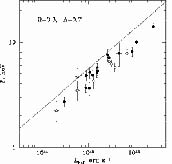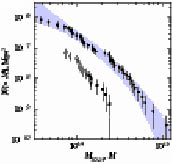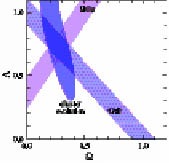


 |
 |
 |
Clusters of galaxies are complex, multi-component systems with hundreds of galaxies, a hot (107 to 108K) intracluster medium (ICM), and dark matter evolving in tightly coupled ways. Clusters are unique because of their size. As the most massive bound objects, clusters are the ultimate manifestations of cosmic structure building. A massive, rich cluster with Mtotal ~ 1015 Msun forms from a density perturbation of radius ~15 Mpc. On these huge scales, most of the mass is dark. Only a few percent of the mass in clusters lies in the optical galaxies. In rich clusters, most of the luminous baryonic mass is in the hot ICM, which comprises about one fifth of the total mass. Since clusters form from such large volumes of space, their mass composition is thought to be representative of the universe.
Since most of the luminous matter in clusters is hot gas, X-ray observations provide unique insights into the physics of clusters. For example, while in relaxed clusters, the hot ICM traces the total cluster mass, in merging systems, the gas maps the often complex structure and provides information on gas heating through shocks. In the centers of clusters, cooling gas may fuel AGN, which in turn can reheat most of the cooling gas. And finally, since the evolution of cosmic structure depends strongly on the cosmology of the Universe, X-ray observations of samples of clusters can constrain cosmological parameters.
The sensitivity and exquisite angular resolution in the Chandra images has led to quantitative changes in our understanding of how clusters grow and evolve. This article touches on only a few examples of the insights Chandra observations provide. First, we illustrate the small scale structures seen in cluster cores and generally associated with relativistic plasma produced in active nuclei, second, the effects of subsonic or supersonic mergers and finally, comment on cluster evolution.
The Complex Centers of Clusters
The high gas density and cooler temperatures in the centers of clusters led to the "standard" cooling flow model in which large quantities of gas (hundreds to thousands of solar masses each year) cool in the cluster core (e.g. Fabian 1994). However, one of the first surprises from the XMM-Newton gratings and Chandra was the lack of cool gas in the centers of cooling flow clusters (e.g. Kaastra et al 2001, David et al. 2001). In some clusters, the observations limit the amount of cool gas to below 10% of that predicted by the standard cooling flow model. While these observations are difficult to reconcile theoretically, the amounts of cool gas detected in the X-ray observations are in close agreement with the observed star formation rates in these systems and with the amount of cool material detected at other wavelengths.
One of the basic assumptions in the standard cooling flow model is the lack of a heat source that could resupply the heat lost by radiative cooling. Chandra images have shown evidence of heat sources. In particular, Chandra images (see examples in Fig. 1) showed complex structures in cluster cores often in the form of X-ray cavities associated with radio lobes.
One of the clearest examples of the effect of plasma bubbles on the hot intracluster medium is in the Perseus cluster around the active central galaxy NGC1275 (see Fig. 1). First studied in detail with ROSAT (Bohringer et al. 1993), Chandra showed that the X-ray cavities that coincide with radio lobes have cool bright rims (Fabian et al. 2000). In addition to these inner bubbles, Perseus has outer "holes" in its surface brightness. These outer holes, as well as the X-ray cavities seen in a few other groups and clusters, do not coincide with radio lobes. The presence of these ghost cavities suggests that they may have been inflated during an earlier nuclear outburst and synchrotron losses have now depleted the high-energy radio emitting electrons. Lower frequency radio observations are required to determine if the ghost cavities are filled with less energetic electrons.
While Chandra has shown that nuclear outbursts have a major impact on the X-ray morphology of cluster centers, the energetic consequences of these outbursts are still unclear.
The fact that the rims of the X-ray cavities are cool implies that they were inflated too slowly to shock heat the gas. Although the bubbles do not appear to drive shocks into the surrounding gas, they can still provide a significant means for redistributing the energy within cluster cores. In particular, the low gas density found in the cavities compared to the ambient cluster gas means that these bubbles will rise buoyantly. As the buoyant bubbles rise, they will dredge up ("entrain") cooler gas from the cluster center and deposit it at large radii, where it will eventually mix with the hotter gas (for details see Churazov et al. 2002 and references therein). Since any gas that is shock heated during the nuclear outburst will be convectively unstable, the heat resulting from the radio outburst will be redistributed throughout the center of the cluster. Both of these processes will reduce the accumulation of cool gas. Outside the central region, the conduction of heat from the hot ICM into the cooling gas also may be a source of reheating (e.g. Zakamska and Narayan 2003). It may be that convection at the very centers of clusters and conduction at large radii are both required to replenish the energy radiated away in the cooling flow and thereby reconcile the predictions of the "standard" cooling flow model with the new X-ray observations.

|

|
 |
Cluster Evolution and Mergers
Our best current understanding of the formation of clusters is that they form hierarchically from smaller groups and subclusters and that, even today, matter continues to rain onto clusters, preferentially along the directions of large scale filaments that intersect at nodes defined by rich clusters. While relatively rare, major mergers of a large subcluster with a rich cluster dissipate a significant fraction of the subcluster's kinetic energy through gas dynamic shocks that heat the intracluster gas. These mergers also may accelerate high-energy particles, producing halo radio sources. As shown through two examples described below, Chandra observations of such mergers are providing new insights into cluster formation processes.
Prior to Chandra, the cluster A3667 was known to have a sharp gas density discontinuity, which was expected to be a shock front resulting from an on-going merger. But Chandra images (Fig 2) showed this was not a shock, but instead was a cold front, the boundary between a dense cold cloud associated with a merging subcluster and the hot cluster (Vikhlinin et al. 2001 a, b). Precise measurements of the gas density, temperature and pressure yield the subcluster velocity. The factor of two difference in pressure across the front implies a Mach number for the subcluster of ~ 1 (a velocity of about 1400 km sec-1). The sharpness of the front, less than 3.5" on the sky or only 5 kpc in physical units, requires that the gas dynamic instabilities at this boundary be suppressed, probably by magnetic fields. If these instabilities were not suppressed, the edge should be broader, since the electron Coulomb mean free path is ~ 13 kpc. In the subcluster, the dark matter halo moves in front of the cold gas and pulls it along, maintaining the global stability of the front and suppressing the small-scale Rayleigh-Taylor instabilities. The observed velocity of the gas flow implies that the sharp front would be destroyed by the Kelvin-Helmholtz instability. However, the generation of a magnetic field surface tension along the front, as shown schematically in Figure 2c can suppress this instability. For the subcluster in A3667, a gas layer with an ~ 10 mG magnetic field is required to lie along the cold front. South of the front, Figure 2b shows a second weaker surface brightness discontinuity that is probably associated with the bow shock in front of the cold cloud, implying that the velocity of the front is slightly supersonic.
The best example of a supersonic merger is the hot (~ 15 keV), distant (z=0.3) cluster 1E0657-56, also known for reasons that will soon become clear as the bullet cluster (Markevitch et al. 2002). Fig 3 shows the recent, deep Chandra image of this cluster, along with the isointensity X-ray contours superposed on an optical R-band image. The X-ray image shows the "bullet" subcluster just exiting the cluster core and traveling west. In front of the bullet is a bow shock. The jumps in temperature and density across this front require supersonic motions, with a Mach number of 2-3. The 3000-4000 km sec-1 velocity of the bullet implies that the subcluster passed through the core of the main cluster only about 0.1 Gyr ago. The shuttlecock shape of the bullet shows that the subcluster continues to be actively destroyed by gas dynamic instabilities. As seen in Fig 3 (right), its gas lags behind the subcluster galaxies due to the ram pressure of the cluster gas that retards the gas in the bullet subcluster. The unique characteristics of the shock and supersonic subcluster allow several interesting measurements, including a possible opportunity to constrain the collisional nature of dark matter. In particular a comparison of the dark matter distribution (as measured by weak lensing) to the location of the subcluster galaxies and the lagging gas would determine if the dark matter is collisionless (like the galaxies) or if it undergoes an analog of ram pressure (like the gas).
 |
 |
Evolution and Cosmology
In theory, cluster evolution is simple, being driven by the gravity of the underlying mass field of the Universe and the collisionless collapse of dark matter. The growth of large scale structure is sensitive to the value of W the density parameter, but only weakly dependent on the cosmological constant L. However while observations of cluster evolution should provide a robust measure of the evolution of cosmic structure and constraints on the cosmology, the amount of evolution has been in contention.
The high X-ray luminosity of clusters allows them to be studied at great distances. Large samples of distant clusters were observed by Einstein, notably in the EMSS, and by ROSAT. These studies showed the first and best evidence for evolution in the luminosities of clusters. In particular, these studies found a dearth of high luminosity clusters at high redshifts (Henry et al. 1992, Gioia et al 2001, Vikhlinin et al. 1998).
While many distant clusters have been studied in detail with Chandra, the analysis of the global X-ray properties for samples of distant clusters has recently provided more evidence for cluster evolution as well as constraints on the underlying cosmology. In particular Chandra observations of 22 distant (z > 0.4) clusters show that the correlations between gas temperature, X-ray luminosity and gas mass all evolve between z > 0.4 and the present (Vikhlinin et al. 2002). Fig 4 shows the L-T and L-gas mass relation for the distant clusters compared to that found for present epoch systems. These observations show that high redshift clusters are systematically denser than clusters are today, and also hotter and more luminous for a given mass. Chandra observations of distant clusters also show a strong evolution in the baryon mass function which provides new constraints on the cosmology (Vikhlinin et al. 2003). The baryon mass function is used as a proxy for the total mass function since both observations and theory argue that the baryon fraction in rich clusters is constant. Figure 5 (left) shows the change in the baryon mass function for the distant clusters compared to a present epoch sample. Figure 5 (right) shows the constraints placed on cosmological parameters Ω and Λ from the cluster evolution compared to the constraints from the distant supernovae and the Cosmic Microwave Background (CMB). All three very different methods show very good agreement with both the supernovae and cluster results requiring a non-zero value for Λ.
In this article, we have touched briefly on several areas of cluster research that illustrate some of the new science that Chandra has produced.
 |
 |
 |
 |
Christine Jones, Larry David, Bill Forman, Maxim Markevitch, Steve Murray, Leon Van Speybroeck, & Alexey Vikhlinin
References
Bohringer, H., Voges, W., Fabian, A., Edge, A., & Neumann, D. 1993 MNRAS 264, L25
Churazov, E., Sunyaev, R., Forman, W., and Bohringer, H. 2002 MNRAS 332, 729
David, L., Nulsen, P., McNamara, B., Forman, W., Jones, C., Ponman, T., Robertson, B., Wise, M. 2001, ApJ 568, 163
Fabian, A.C. 1994 ARA&A 32, 277.
Fabian, A. C., Sanders, J., Ettori, S., Taylor, G., Allen, S. W., Crawford, C. S., Iwasawa, K., Johnstone, R. M., Ogle, P. M. 2000 MNRAS 318, L65
Gioia, I. M.; Henry, J. P.; Mullis, C. R.; Voges, W.; Briel, U. G.; B Gioia, I. M., Henry, J. P., Mullis, C. R., Voges, W., Briel, U. G., Bohringer, H., Huchra, J. P. 2001 ApJ 553, L105
Henry, J.P., Gioia, I. M., Maccacaro, T., Morris, S. L., Stocke, J. T., Wolter, A. 1992 ApJ 386, 408
Kaastra, J., Ferrigno, C., Tamura, T., Paerels, F., Peterson, J., & Mittaz, J., 2001 A&A 365, L99
Markevitch, M., Gonzalez, A., David, L., Vikhlinin, A., Murray, S., Forman, W., Jones, C., Tucker, W. 2002 ApJ 567, L27
Vikhlinin, A., Markevitch, M, & Murray, S. 2001a, ApJ 551, 160
Vikhlinin, A., Markevitch, M, & Murray, S. 2001b, ApJ 549, L47
Vikhlinin, A., McNamara, B. R., Forman, W., Jones, C., Quintana, H., Hornstrup, A. 1998 ApJ 498, L21
Vikhlinin, A., VanSpeybroeck, L., Markevitch, M., Forman, W., Grego, L. 2002 ApJ 578, L107
A. Vikhlinin, A. Voevodkin, C. R. Mullis, L. VanSpeybroeck, H. Quintana, B. R. McNamara, I. Gioia, A. Hornstrup, J. P. Henry, W. Forman, C. Jones 2003 astro-ph 0212075
Zakamska, N. & Narayan, R. 2003 ApJ 582, 162